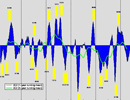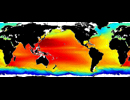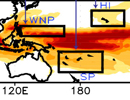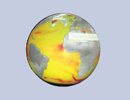CPC Monthly Merged Analysis of Precipitation (CMAP), version 1708
The CPC Merged Analysis of Precipitation (CMAP) is a technique which produces pentad and monthly analyses of global precipitation in which observations from raingauges are merged with precipitation estimates from several satellite-based algorithms (infrared and microwave).
These data are comparable (but should not be confused with) similarly combined analyses by the Global Precipitation Climatology Project which are described in Huffman et al (1997).
It is important to note that the input data sources to make these analyses are not constant throughout the period of record. For example, SSM/I (passive microwave - scattering and emission) data became available in July of 1987; prior to that the only microwave-derived estimates available are from the MSU algorithm (Spencer 1993) which is emission-based thus precipitation estimates are avaialble only over oceanic areas. Furthermore, high temporal resolution IR data from geostationary satellites (every 3-hr) became available during 1986; prior to that, estimates from the OPI technique (Xie and Arkin 1997) are used based on OLR from polar orbiting satellites.
The merging technique is thoroughly described in Xie and Arkin (1997). Briefly, the methodology is a two-step process. First, the random error is reduced by linearly combining the satellite estimates using the maximum likelihood method, in which case the linear combination coefficients are inversely proportional to the square of the local random error of the individual data sources. Over global land areas the random error is defined for each time period and grid location by comparing the data source with the raingauge analysis over the surrounding area. Over oceans, the random error is defined by comparing the data sources with the raingauge observations over the Pacific atolls. Bias is reduced when the data sources are blended in the second step using the blending technique of Reynolds (1988). Here the data output from step 1 is used to define the ""shape"" of the precipitation field and the rain gauge data are used to constrain the amplitude.
The monthly data set consists of two files containing monthly averaged precipitation rate values. Values are obtained from 5 kinds of satellite estimates (GPI,OPI,SSM/I scattering, SSM/I emission and MSU). The enhanced file also includes blended NCEP/NCAR Reanalysis Precipitation values. The other just includes the satellite estimates.
Citation:
Xie, P., and P.A. Arkin, 1997: Global precipitation: A 17-year monthly analysis based on gauge observations, satellite estimates, and numerical model outputs. Bull. Amer. Meteor. Soc., 78, 2539 - 2558.
Please note: If you acquire CMAP Precipitation data products, we ask that you acknowledge them in your use of the data. This may be done by including text such as CMAP Precipitation data provided by the NOAA/OAR/ESRL PSD, Boulder, Colorado, USA, from their Web site at https://www.esrl.noaa.gov/psd/ in any documents or publications using these data. They would also appreciate receiving a copy of the relevant publications. This will help PSD to justify keeping the CMAP Precipitation data set freely available online in the future. Thank you!
References:
Huffman, G. J. and co-authors, 1997: The Global Precipitation Climatology Project (GPCP) combined data set. Bull. Amer. Meteor. Soc., 78, 5-20.
Reynolds, R. W., 1988: A real-time global sea surface temperature analysis. J. Climate, 1, 75-86.
Spencer, R. W., 1993: Global oceanic precipitation from the MSU during 1979-91 and comparisons to other climatologies. J. Climate, 6, 1301-1326.
Xie P., and P. A. Arkin, 1996: Global precipitation: a 17-year monthly analysis based on gauge observations, satellite estimates, and numerical model outputs. Bull. Amer. Meteor. Soc., 78, 2539-2558.
| Variables |
Precipitation (mm/day)
|
| Zonal | Global by 2.5 deg |
| Meridional | Global by 2.5 deg |
| Vertical | surface |
| Temporal | Jan 1979 to Aug 2018 by 1 month(s) |
| Static? | no |
| Volume | 13 MB / month |
| Server | public:      |
| Source | http://www.esrl.noaa.gov/psd/data/gridded/data.cmap.html |
| Acquired | Nov 25, 2014 (Updated Sep 2018) |
| APDRC contact | |
| Supplements |































